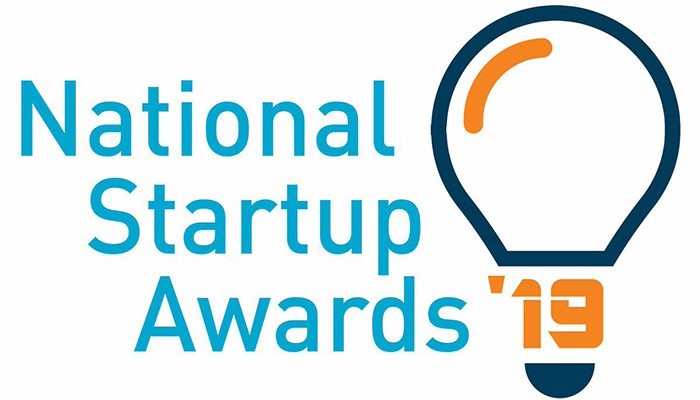
Gold in the Emerge-Tech Category!
24/08/2021SaaS Platforms – The Customer Signup Process
Our CEO, Liz, came across a very interesting article from InnerTrends (we have shared the key insights below), that talks about the process of customer signups and how they affect SaaS growth. Written by InnerTrends Co-Founder Claudiu Murariu, the primary focus is on two different approaches to on-boarding: fast signup and considered signup, with the pros and cons of each and some case studies exemplifying A/B testing experiences of these approaches.
We wanted to share the insights from this post because found them extremely interesting and felt that they warranted further discussion; it got us thinking about the signup process for a SaaS platform, and what best practices should look like. We have shared our own thoughts below the article. And make sure to check out Claudiu’s other articles on InnerTrends here.
Fast Signup vs Considered Signup – A SaaS Growth Experiment
Author: Claudiu Murariu
The fast signup presents your visitor with the option to sign up for your product or service as soon as he lands on your website.
The barrier for signup is kept very low, not too many details are asked for, so even a bit of curiosity will drive signup. (Be honest, how many times have you been persuaded by the words “No credit card required!” when you were wavering?)
The goal for the fast signup is to bring in as many leads as possible so that there’s a big pool of users to convert into paying customers. The focus is on quantity rather than quality.
The considered signup approach gives the visitor an opportunity to learn more about your product or service before making a decision to sign up.
A considered signup will undoubtedly have fewer initial signups, but will retain a lot of committed people who ultimately will become paying customers. This process takes a bit longer and its focus is on quality rather than quantity.
Which is better? There is no ‘one size fits all’ answer to this question. It’s about which method works best for you and your business.
The Impact on Your Business
Jason Lemkin from SaaStr argues for considered signups, or at least a mixed signup strategy.
From Jason’s perspective, there is a big difference between the way enterprises sign up (accounting for 85% of revenue) and the way small businesses and regular users sign up (which accounts for the other 15% of revenue).
A small business is interested in getting a free trial or to sign up right away, whereas enterprises have a different approach and are interested in getting a demo of the product. How many enterprise customers can you close with your small and medium business (SMB) product? By pushing for the signup right away, not even allowing users to see pricing before signing up, it’s possible that you might alienate enterprise users who just want a demo of your product and to be put in touch with a representative.
Fast signup is typical for freemium products, whereas considered signup is typical for enterprise products, but not limited to them: request a demo, learn more, credit card first, etc. Mixed signup strategies are more often used when targeting both small companies and enterprises. All of the mixed signup strategies started as fast signup only strategies and, over time, added considered signup strategies.
How to Experiment With Fast Signup vs. Considered Signup
A critical element for any experiment is to set the correct success metric. If you simply ask: ‘How many people create an account?’ a fast signup strategy is almost always going to win. If those newly created accounts become inactive almost right away, your business will not grow, regardless of how many hundreds or thousands of new accounts are created.
Experiment in stages. Choose winners based on immediate results (first order revenue, average order value) while also monitoring the experiment in the longer term via these other metrics.
While it would take at least a full business cycle to declare a winner, it only makes sense to focus on revenue. The question is, which revenue metric? First acquisition revenue, lifetime value, average order value, or average revenue per customer?
Average revenue per customer, lifetime value, or (even better) lifetime value per cost of acquisition would all be relevant metrics to find which signup works best, but it’s going to take a very long time to find your winner.
Fast signup will bring you more leads but they may not be quality leads. Automation tools can be used to onboard as many users as possible and convert them into paying customers.
Considered signup will bring you quality leads, but less of them. With less leads to follow up, you have the opportunity to make personal connections with these new users in order to convert them into paying customers.
Based on this information, choose and set appropriate goals. For example:
- I want more leads so I can focus on onboarding and conversion optimization
- I want enterprise customers to increase average revenue per user
- I want quality leads so I can build a sales team to convert them
Let’s play with an example and say I want quality leads so I can build a sales team to convert them. A typical considered signup strategy for increasing quality leads is to require credit card details when signing up. This causes users to make a considered decision.
Knowing your goal, how do you decide if this strategy is working?
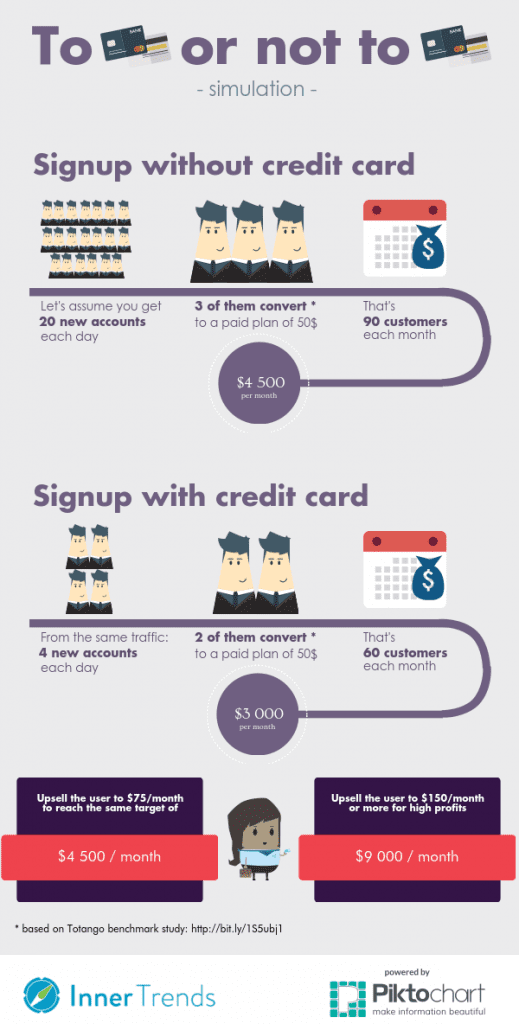
Requesting the credit card details during the signup process is a strategy that works for companies like Moz and SEMrush. They have been doing it for years.
It’s important to note that the way you ask for the credit card details in the signup process can have a huge impact on the final results.
According to a case study facilitated by Avangate, Absolute managed an amazing 5x increase of the trial conversion rate. They added a trial sign-up form requiring credit card information in the signup process instead of a simple checkout page with a pricing listing at zero dollars. The initial version did not automatically trigger the product activation and auto-billing at the end of the trial period. Users would need to do the activation manually, resulting in trial periods starting late or never starting. Here is a before and after image for the experiment:
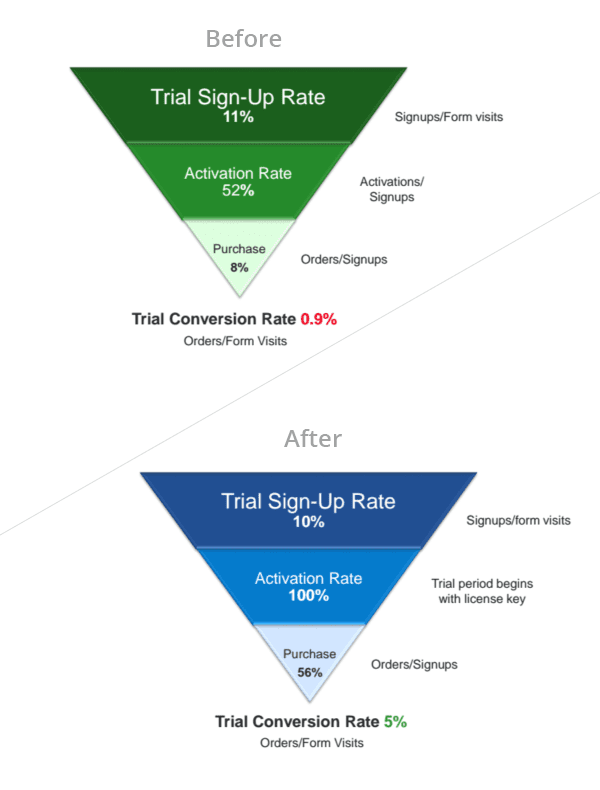
In 2012, Totango did a study in which they collected data from 100 online businesses and analyzed the trial conversion and user retention rates. The data revealed that free trial signups were more successful when credit card information was not required.
Ultimately, the only way to find the best signup process for your business is to test, measure and experiment. What works for one business may not work in exactly the same way for you, but you can not know that without experimenting and testing.
When a Fast Signup is Not Fast Enough
37signals Case Study
Basecamp (formerly 37signals) shared a couple of lessons they learned from their transition. They decided to make their website the home of the company, not just the home of the product. Major changes were made to the brand, products, and design during this process.
One of the most significant changes was the removal of the signup form from the homepage. This can’t be described as a considered decision. They didn’t do any extensive research or testing on the signup process. Neither was the decision made based on data. They didn’t have a measured way to see how this change would impact the signups and they didn’t explicitly decide to go for a considered signup system.
Instead, they simply wanted to keep a consistent image during a time of transition. No one paid attention to what this change might mean.
However, after implementing the changes in February 2014, they did notice a fall in their conversion rate. The number of people who were signing up for the new Basecamp website decreased despite press coverage and more traffic.
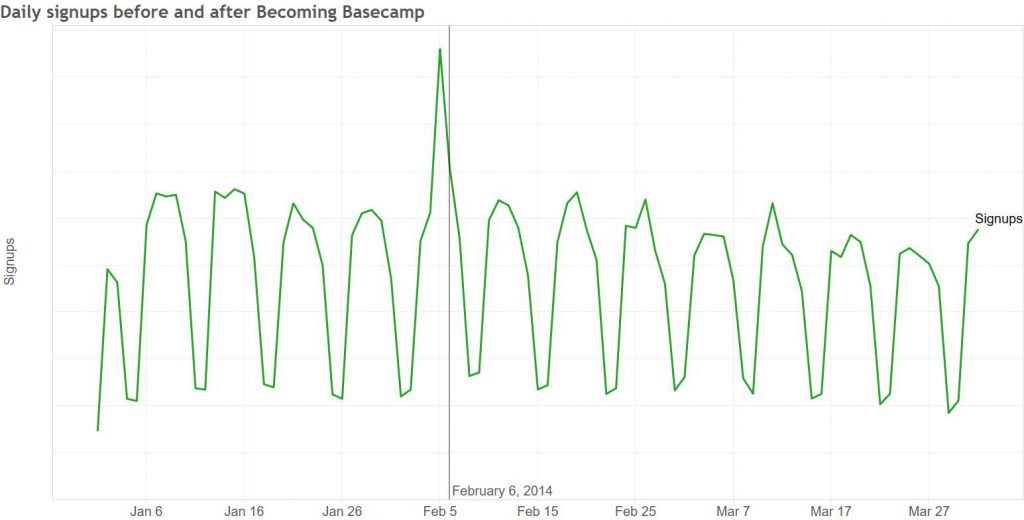
Without planning on doing so, they had accidentally implemented a considered signup system.
In the fall of 2014, when signups didn’t start picking up, they started asking questions.
Things didn’t improve during the first half of 2015 either and, even though the topic was discussed regularly within the company, no major changes were made.
Finally, in July 2015, Basecamp launched an A/B test with the old signup form back on the homepage. The signups immediately increased by 16%. It quickly became apparent that they had lost millions of dollars by delaying the split test for so long.
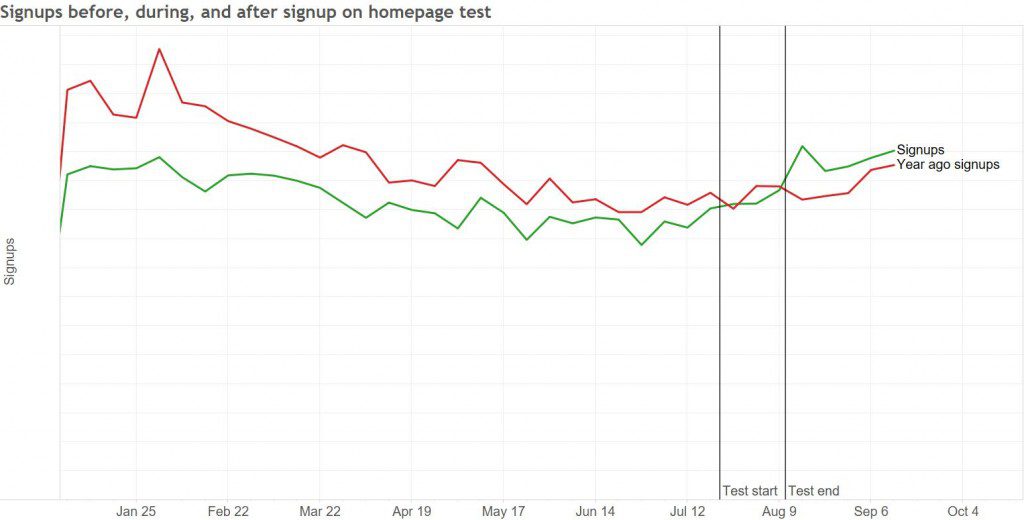
What We Learned From This Experience
Running an A/B test can help you catch the leaks and draw a direct connection between the changes you’re making and the signup rates. It can become really easy to just ignore or delay testing the changes being implemented
Be sure to share your ideas with the team. Discussing the change with them might bring up the risks involved. In this particular scenario, it took six months for the problem to be identified due to a lack of communication
To Sum it All Up
There’s no one size fits all. You have to decide which type of signup is best for your business. Always test. Absolute adjusted their credit card requirements and managed a 5x increase in sales because of it. Simulating different signup strategies for your SaaS can reveal the easiest path to more profit.
Thoughts from SalesOptimize
Firstly, we want to thank Claudiu for such an insightful piece of research. We also agree wholeheartedly with his comment regarding which signup process is better: “There is no ‘one size fits all’ answer to this question. It’s about which method works best for you and your business.”
However, we also feel that as a startup, your first year of business will inevitably pose a challenge in influencing customers to sign up to your platform, be it a trial or paid subscription. During the brand awareness stage, you need to build trust and authority. Therefore a considered signup may not be very effective. It’s more likely that a fast signup would be the preferred method – but that doesn’t mean enterprise customers cannot be targeted using this method.
A fast signup process can still involve enough information for a visitor to understand more about the product and what they are committing to: i.e. by implementing a ‘How it Works’ guide and a visible pricing model. For example, MailChimp offers a fast signup process, but also allows visitors to see their pricing plans before registering.

We feel that this is most certainly a good strategy to implement if you’re considering the fast signup approach. There are, of course, merits with either approach, and to echo Claudiu’s sentiments, A/B testing is a great way to find out which works best for your business – it might even be a mixed approach. Using a tool like Mouseflow can also help to identify where visitors are scrolling, clicking, and even hovering on your website. You can also use Google Tag Manager to create event paths and use tracking codes on your call to action buttons to assess how effective they are.
Whatever approach you decide to take with your signup process, it’s important to ensure that you consider the impact it has on your business and what decision will work best in the long run.









